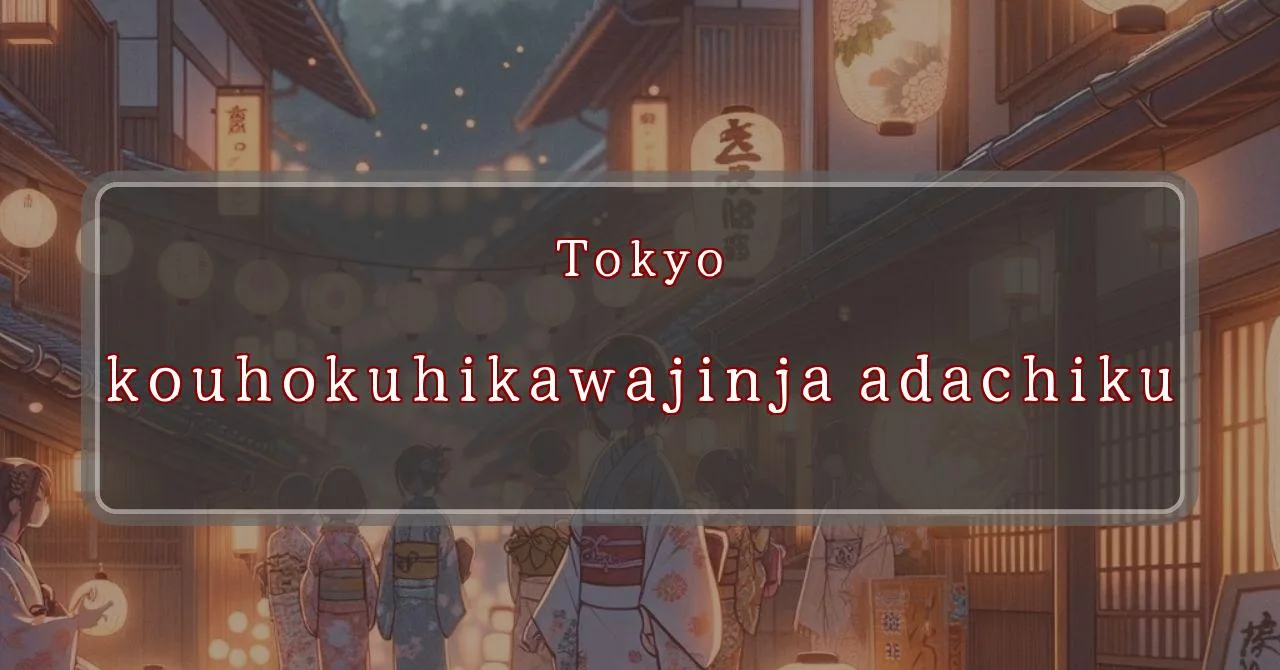Enchanting shrine festival in Tokyo with stunning illuminations
Shinto shrine located in Adachi Ward, Tokyo, Japan. It is dedicated to the god Susanoo-no-Mikoto, the god of storms and the sea.
- Address: 2-43-8 Kohoku, Adachi-ku, Tokyo 123-0872
- Phone Number: 03-3897-6483
- Access: 15-minute walk from Kohoku Station on the Tokyo Metro Chiyoda Line
- Festival Days: September (exact dates to be announced)
Main Events and Attractions of the Festival
The Kohoku Hikawa Shrine Festival is a vibrant and lively event that offers a variety of attractions for visitors of all ages. Some of the main highlights include:
Mikoshi Procession
One of the central events of the festival is the mikoshi procession, where a portable shrine is carried through the streets of the neighborhood. The mikoshi is believed to house the spirit of the deity enshrined at the Kohoku Hikawa Shrine, and the procession is a way to pay respect and show gratitude to the deity.
- Overview: A parade of portable shrines through the streets
- Significance: A way to honor and express gratitude to the enshrined deity
Traditional Performances
During the festival, visitors can enjoy a variety of traditional Japanese performances, including:
- Kagura: A sacred Shinto dance performed by shrine maidens
- Taiko drumming: A powerful and energetic performance using traditional Japanese drums
- 獅子舞: A lion dance that is believed to bring good luck and ward off evil spirits
Food and Games
The festival also features a variety of food stalls and games, offering a chance to sample local delicacies and try your luck at traditional Japanese games.
- Food Stalls: A variety of food stalls offering local specialties and traditional Japanese dishes
- Games: Traditional Japanese games such as ring toss and goldfish scooping
Fireworks Display
The festival culminates in a spectacular fireworks display, lighting up the night sky with vibrant colors and patterns.
- Overview: A grand fireworks display to conclude the festival
- Significance: A symbol of joy, celebration, and the end of the festival
Blessings and Deities
The Kohoku Hikawa Shrine is dedicated to the deity Susanoo-no-Mikoto, the god of storms and the sea. Susanoo-no-Mikoto is known for his fierce and powerful nature, but he is also revered as a protector and a bringer of good fortune.
- Deity: Susanoo-no-Mikoto
- Significance: God of storms and the sea, protector, bringer of good fortune
Origin and History
The Kohoku Hikawa Shrine has a long and rich history, dating back to the Edo period. It is believed that the shrine was originally established as a small shrine dedicated to Susanoo-no-Mikoto by local villagers. Over time, the shrine grew in popularity and became an important religious center for the community.
- Establishment: Edo period
- Founder: Local villagers
- Development: Grew in popularity and became an important religious center
Tips and Notes for Visitors
If you plan to visit the Kohoku Hikawa Shrine during the festival, here are a few tips and notes to keep in mind:
- Dress respectfully: As with any religious site in Japan, it is important to dress respectfully when visiting the Kohoku Hikawa Shrine. Avoid wearing shorts, tank tops, or other casual clothing.
- Remove your shoes: When entering the main shrine building, you will need to remove your shoes. There will be a designated area where you can leave your shoes before proceeding inside.
- Offer a donation: It is customary to offer a small donation to the shrine when you visit. There will be a donation box near the entrance of the main shrine building.
- Participate in the festival activities: The Kohoku Hikawa Shrine Festival offers a variety of activities for visitors to enjoy, such as the mikoshi procession, traditional performances, and food stalls. Be sure to take part in these activities to fully experience the festival.
Parking Information
There is limited parking available at the Kohoku Hikawa Shrine. If you are driving to the festival, it is recommended to arrive early to secure a parking spot. Alternatively, you can use public transportation to get to the shrine. The nearest station is Kohoku Station on the Tokyo Metro Chiyoda Line.
- Parking: Limited parking available at the shrine
- Recommendation: Arrive early to secure a parking spot
- Public transportation: Take the Tokyo Metro Chiyoda Line to Kohoku Station
Popular Stalls and Food Carts in Recent Years
| Type of Stall | Description |
|---|---|
| Takoyaki | A staple at Japanese festivals. Characterized by a crispy outside and a creamy inside. |
| Jaga Butter | A simple yet popular snack of hot potatoes lavishly topped with melted butter. |
| Baby Castella | Small castella cakes, sweet and fluffy treats enjoyed by children and adults alike. |
| Grilled Ayu with Salt | Fresh ayu fish grilled whole with salt, a savory taste of Japanese summer. |
| Shaapin | A unique gourmet item influenced by foreign cuisine, with a chewy skin wrapping the filling. |
| Okonomiyaki | A Japanese grilled dish where you often choose your own ingredients for a personalized flavor. |
| Cotton Candy | A fluffy, sweet snack that’s extremely popular with children. |
| Chocolate Banana | A banana coated in chocolate, a fun and visually appealing dessert. |
| Kushiyaki | Various types of ingredients skewered and grilled, an easy-to-enjoy snack. |
| Yakisoba | Fried noodles mixed with a special sauce, a fast food favorite in Japan. |



